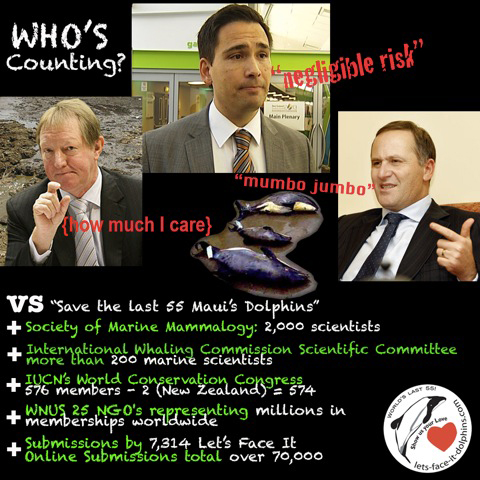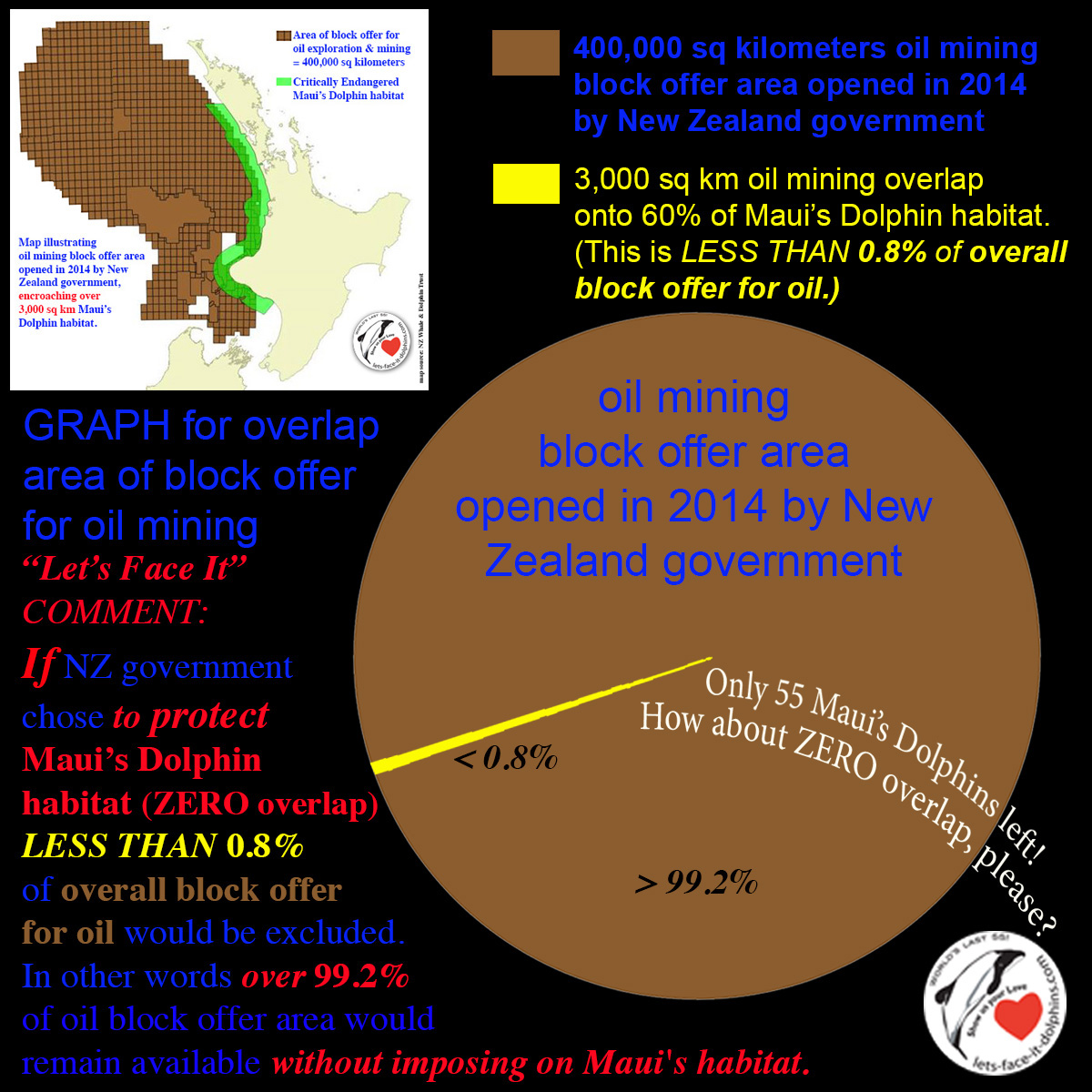

10 September 2014 by Peggy Oki

Battles are being hard fought for the world's smallest, rarest dolphin in New Zealand -- a nation perceived as “green” but currently only in theory, not action.
Through documents obtained under the country’s Official Information Act, New Zealand’s Green Party announced a dirty truth about National Party's recent action. Of the over 400,000 square kilometers of the country’s land and sea area, the largest such block offer in New Zealand history,the government opened up for oil exploration and mining an area of over 3,000 square kilometers overlaps the West Coast North Island Marine Mammal Sanctuary, home to the critically endangered Maui’s dolphin.

In response to a rally of about 300 protesters opposed to this decision, Minister of Energy, Simon Bridges stated: "Obviously when you have a industry like the petroleum industry who bring billions of dollars and thousands of jobs, it would be lunacy to shut it down when there's only a very remote risk of harm to the dolphins."
Chiming in, New Zealand Prime Minister John Key dismissed concerns about allowing oil exploration in waters set aside to protect the world's rarest dolphin as "mumbo jumbo".
But wait! Did Bridges and Key make these statements not knowing that "Underwater, the sound from a seismic air gun can be 100,000 times as intense as a jet engine? Now that the Government is opening up 3,000 square kilometres in the Marine Mammal sanctuary these guns could increasingly be used for exploration and pose a major threat to the Maui's dolphin. Via Skype interview, world-reknowned researcher Lindy Weilgart states seismic air gun blasts could cause permanent hearing loss in cetaceans.
“Seismic surveys have been strongly tied to fatal whale, dolphin and giant squid strandings and deaths at sea,” said Dr Weilgart. "Of course, if you don't look, you won't see. Oil and gas companies do not undertake thorough surveys for whale and dolphin carcasses. Even if they did, only about 3% of dolphin carcasses are ever detected, as they sink or are eaten by predators.”
“Finally, immediate deaths are not the only concern. Seismic surveys can cause dolphins to avoid important habitat, can interfere with their food-finding, reproduction, resting, and hearing sounds vital to their survival, and can cause stress effects. All these can have serious impacts on the welfare of these populations and the welfare of their prey," she said.
Dr Liz Slooten of Otago University says that though observers will be placed on oil survey vessels, they are “virtually useless” and do very little to protect whales. “Overseas research has shown that observers on the seismic testing ships only see around 10% of whales and dolphins in the area. That’s because sperm whales, for example, spend 45 minutes diving and feeding for every 10 minutes they comes to the surface to breathe.”
“Most of the whales that are sensitive to noise will be on the run or already be in deep trouble, before the observers can see them”, said Dr Slooten. “Seismic survey noise can be heard for at least 80 kilometres, but the observers can see whales and dolphins for only one or two kilometres, and then, only when they surface.”
“Beaked and sperm whales are sensitive to seismic sonar explosions for oil exploration that can damage hearing, which whales rely on to navigate, and they can be killed, if they’re very close to the sonic explosions”. About half of the world’s whales, dolphin and porpoise species live in our waters. They often travel huge distances around New Zealand at different times of the year.
Dr Liz Slooten says there are three common responses from when whales are scared by sonar:

Author's Comment: Less than 0.8% of the entire area of block offer, overlaps onto Maui's Dolphin habitat. Sacrificing 0.8% of that entire area seems so small compared to imposing into 60% of protection area for the Maui's. In other words over 99.2% of oil block offer area would remain available without imposing on Maui's habitat. Gee, couldn't National have just excluded that less than 0.8% area of the unprecedented block offer so as to not invade Maui's Dolphin habitat?

At the epicenter of Maui's dolphin habitat, arare pygmy sperm whale beached in early 2013 during seismic testing for oil and gas near Raglan. The cause of death is unknown because the whale was quickly shot and buried before an autopsy could be carried out.
Peggy Oki (Coordinator of "Let's Face It" Visual Petitions) in Raglan at the time received word the next day, immediately inquired to request that a necropsy be performed, however too late. Oki then proceeded to investigate the matter of NZ's Department of Conservation (DOC) policy on euthanization and performing necropsies on stranded marine mammals. Ultimately, a group letter of concern from 25 NGO's was then drafted and sent to DOC with a request for protocols including necropsy to determine cause of death in any cetaceans found in proximity to zones of seismic testing, and to halt this testing if necropsies indicate cause of death as a result of trauma caused by seismic air guns.
The Society for Marine Mammalogy (SMM) comprised of over 2,000 marine scientists worldwide also in a letter to the New Zealand government urged an immediate halt seismic testing in Maui’s dolphin habitat. The President of the Society Prof. Helen Marsh said that "allowing seismic testing in the dolphins’ habitat may harm their hearing and push them into unprotected areas, where they are more exposed to fishing nets. The impact on the 55 remaining Maui’s dolphins could be devastating. Allowing this seismic testing appears inconsistent with the New Zealand Government's stated goal of enabling this subspecies to recover..." https://www.lets-face-it-dolphins.com/news-blog/article-95-2013-04/music-to-the-ears-about-too-much-noise-for-maui-s-dolphins
As if opening up Maui's habitat to oil exploration and mining wasn't bad enough, it was revealed that Minister of Conservation, Dr. Nick Smith lied over Maui's Dolphin.
MP Gareth Hughes of the NZ Green Party questioned the Minister of Conservation on this matter during a parliamentary meeting. View the video here.

Seabed mining can be likened to bottom trawling on steroids, with far more devastating effects on ocean habitat. After a two year battle by Kiwis Against Seabed Mining to prevent seabed mining from being allowed off the west coast of North Island, also where Maui's dolphins are found, the New Zealand's Environmental Protection Authority (EPA) committee rejected the application in June of this year, saying the environmental effects were not well enough understood, stakeholder TransTasman Resources (TTR) consultation had been inadequate, and questioning the commercial viability of the project.
However, TTR announced that they are not going away quietly. The company seeking to dredge up to 50 million tonnes annually of sand rich in titano-magnetite, a type of iron ore, for export to Asian steel mills, will appeal the rejection of its marine consent application by the decision-making committee appointed by the EPA. TTR is the first company to seek a marine consent under new legislation governing economic activity in New Zealand's vast exclusive economic zone, which extends from the 12 mile nautical limit out to 200 kilometres from the coastline.
Dr. Nick Smith (Min. of Conservation, NZ) has repeatedly insisted there is no scientific evidence to suggest Maui's dolphins need further protection over and above the measures currently in place.
1) During her visit last month, Dr. Jane Goodall expressed concern over the NZ govt allowing oil exploration in the marine sanctuary that's home to the endangered Maui's dolphin.
2) At about the same time, now for the third year in a row the International Whaling Commission Scientific Committee (IWC SC), made up of more than 200 marine scientists, called upon the NZ government for urgent action to save the dolphin. This year the IWC SC reiterated its "extreme concern" about the decline of the population of 55 dolphins.
3) We already mentioned the letter of concern from the Society of Marine Mammalogy, backed by 2,000 scientists. (But who's counting? Certainly, not Dr. Smith!)
4) Back in September 2012, the IUCN’s World Conservation Congress, made a motion to stop the extinction of the world’s rarest dolphins and porpoises, including New Zealand’s Hector’s and Maui’s dolphins and Mexico’s vaquitas,. This motion was passed with an overwhelming majority with 576 IUCN members, including governments and NGOs, voted for the motion, and only two opposed. The New Zealand government was one of them.
5) A joint letter of concern from 45 NGO's representing millions in memberships internationally was sent to the NZ government during submissions period.
Additionally, 7,314 Let's Face It Visual Petitions were submitted to the NZ government during submissions period, with a total of over 70,000 Submissions in favor of protecting the Maui's Dolphins from further deaths.
While until only recently many New Zealanders have not known of the plight and valiant efforts save the Maui's dolphins from extinction, a poll last month found 51 per cent of respondents would be more likely to vote for a party that spent money to support the industry's shift to different methods, while 27 per cent said it would have no effect and 10 per cent said it would make them less likely to vote for a party.
It is more than evident that unless the current government is VOTED OUT, the last 55 Maui's Dolphins could become EXTINCT less than two decades from now.
Let's Face It is urging all NZ citizens to vote to replace the current government, with leadership that vows to protect the New Zealand Dolphins and their habitat.
Please URGE ALL of your NZ family & friends to exercise their power of the VOTE!!! Give PM John Key, Min. Simon Bridges, Min. Nick Smith, and the whole lot the BIG BOOT!
AUTHOR'S NOTE: If finding a stranded marine mammal in NZ please call Project Jonah first, before DOC. And if during seismic testing, make a request to DOC for a NECROPSY with results be open to public review. DOC euthanized the above noted Pygmy Sperm Whale by shooting it in the head, destroying possible evidence of direct trauma due to seismic testing going on in that area!
Project Jonah Stranding Hotline: 0800 4 WHALE (0800 4 94253)
You can help to keep record of Maui's dolphins! REPORT all SIGHTINGS by calling: 0800 4 MAUIS (0800 4 62847)
+ + + BE a VOICE for "our" CRITICALLY ENDANGERED (last 55 or LESS!) Maui's & (25% remaining) Hector's Dolphins!!!
Please participate in our "Let' Face It"
Visual Petition campaign!
 Help us reach our new goal of 10,000 "Let's Face It" Visual Petitions! Pledge to COLLECT 5, 10, 15 "Let's Face It" VPs this week?
Help us reach our new goal of 10,000 "Let's Face It" Visual Petitions! Pledge to COLLECT 5, 10, 15 "Let's Face It" VPs this week?
Just 3 easy steps starting with selecting your favorite image of a Maui's/Hector's Dolphin at Step 1: https://www.lets-face-it-dolphins.com/step-1-download-image
Read more on current NZ government shenanigans: Threat Management Plan from a government with deaf ears!!